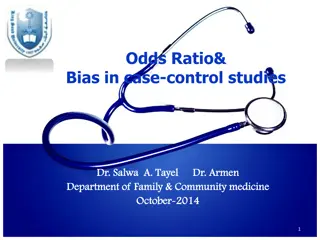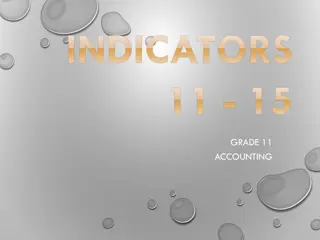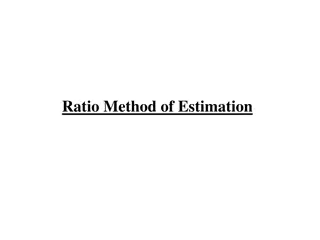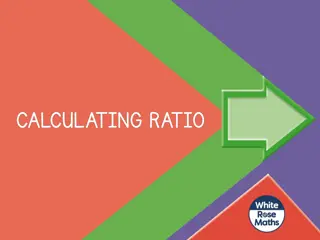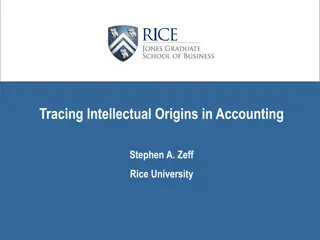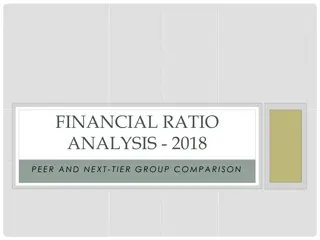Understanding Ratio Analysis in Accounting
This educational material explores the essential concepts of ratio analysis in accounting, focusing on the interpretation of financial statements to assess company performance, establish trends, aid in decision-making, and facilitate comparisons. The content covers the objectives and users of ratio analysis, classification of ratios including profitability and efficiency, and explanations of key ratios like Return on Capital Employed (ROCE) and working capital ratios.
Download Presentation

Please find below an Image/Link to download the presentation.
The content on the website is provided AS IS for your information and personal use only. It may not be sold, licensed, or shared on other websites without obtaining consent from the author. Download presentation by click this link. If you encounter any issues during the download, it is possible that the publisher has removed the file from their server.
E N D
Presentation Transcript
LEAVING CERTIFICATE ACCOUNTING Ratio Analysis and Interpretation of Financial Statements Part A
Objective of Ratio Analysis Analyse the performance of the company from one year to the next Use ratios to establish trends and patterns Help with decision making Compare companies
Management Shareholders both existing and potential Lenders, both existing and potential Customers, both existing and potential Competitors USERS OF RATIOS
Classification of Ratios Profitability and Efficiency Ratios Working Capital Ratios Liquidity/Solvency Ratios Gearing Ratios Investment Ratios
Profitability and Efficiency Ratios Return on Capital Employed (ROCE) Profit before interest and tax x 100 Return on Shareholders Funds Gross Profit Margin Capital Employed Net profit after tax and preference dividend x100 Ordinary Shares +Reserves Gross Profit x100 Cost of Sales Net Profit Margin Net Profit before interest and tax x100 Sales Total Expenses to Sales Total Expenses x100 Sales Asset Turnover Fixed Asset Turnover Sales Total Assets Sales Fixed Assets Working Capital Turnover Sales Working Capital
Profitability and Efficiency Ratios 1. Return on Capital Employed (ROCE) The Return on Capital Employed measures profit as a percentage of the capital invested in the company. This ratio should always be compared with the return on a Risk Free Investment i.e. bank deposit account. 2.Return on Shareholder Funds (ROSF) The Return on Shareholder Funds Ratio measures a company s return to its ordinary shareholders on the capital they have invested. 3.Gross Profit Mark-up/Margin Measure the efficiency of production 4.Net Profit Margin Profitability of a company relative to sales after deducting all operating expenses. 5.Total Expenses to Sales Measures the efficiency of management in controlling costs. 6.Asset Turnover, Fixed Asset Turnover and Working Capital Turnover Measures the efficiency of the company in using its various classes of assets to generate profits.
Working Capital Ratios Stock Turnover Cost of Sales Average Stock (Opening and Closing Stock/2) Average Period of Credit Allowed Trade Debtors x365 (or 12) Credit Sales Average Period of Credit Received Trade Creditors Credit Purchases x 365 (or 12)
Working Capital Ratios Stock turnover measures the number of times stock is sold during a trading period. Remember only to compare firms in the same industry. An unfavourable comparison of stock turnover ratios may indicate: Inefficiency in production Poor stock control Obsolete stock lines A drop in sales demand Average Period of Credit Allowed Measures the time in days/months between credit sales to debtors and cash receipts from them. A long credit period to indicates poor credit control. Average Period of Credit Received Measures the time in days(or months) between credit purchases from creditors and cash payments to them. This may be used as a short term source of finance.
Liquidity/Solvency Ratios Current Ratio Current Assets Current Liabilities Liquid Ratio Current Assets (less Closing Stock) Current Liabilities
Liquidity/Solvency Ratios Liquidity measures the ability of a company to pay its short term debts as they fall due. Solvency is the ability of a company to pay all its debts as they fall due for payment. A business is solvent if its total assets are more than liabilities. Current Ratio Measures a company s ability to pay its current liabilities in less than 1 year. The ideal ratio here is 2:1 Liquid Ratio ( Acid Test) A more severe test of liquidity as it excludes closing stock ( as this must be sold before it is cash) The ideal here is 1:1
Liquidity/Solvency Ratios Liquidity problems and overtrading Overtrading occurs when the business is trying finance too high a volume of sales with too little working capital. A business which is overtrading may appear ok until there is closer examination. There will be a large increase in debtors and creditors and a shortage of cash. Creditors may insist on payment and this may eventually lead to liquidation. Steps to solve a liquidity problem 1. Enforce a strict credit policy by insisting that debtors pay earlier offer cash disocunts 2. Issue any remaining shares from authorised share capital 3. Take out a company loan 4. Keep stock levels to a minimum 5. Use sale and leaseback of assets 6. Postpone any planned capital projects 7. Avoid paying dividends.
Gearing Ratios Debt/Equity Ratio Debt Capital : Equity Capital Debt/Total Capital Percentage Interest Cover Debt Capital Total Capital x100 Operating Profit (Net Profit + Interest ) Interest charges
Gearing Ratios Debt/Equity Ratio The Debt/Equity Ratio measures the ratio between Debt Capital (which loans, debentures and preference shares) and Equity Capital (which is shareholder funds) If the ratio is greater than 1:1 the company is said to be highly geared, less than 1:1 low geared and at 1:1 neutral. Debt /Total Capital Percentage The Debt/total Capital Percentage is the same information on capital structure, expressed differently. This shows what percentage of total capital is represented by Debt Capital Over 50 % is highly geared and less than 50 % is low geared. 50 % is neutral. Interest Cover This measures a company s ability to meet its fixed interest cover commitments. A high cover indicates the company has no issue with payment.
Investment Ratios Earnings per Share Profit (After Tax and Preference Dividends) Number of Issued Ordinary Shares Dividend per Share Total Ordinary Dividend Number of Issued Ordinary Shares Price Earnings Ratio Market Price per Share Earnings Per Share (EPS) Price Dividend Ratio Market Price per Share Dividend Per Share Dividend Yield Dividend Per Share x100 Market Price Per Share Dividend Cover Profit (After Tax and Preference Dividends) Total Ordinary Dividend
Investment Ratios Earnings Per Share (EPS) Measures the earnings in cent of each issued ordinary share. Dividend per Share (DPS) The Dividend per Share is the amount of dividend for the year expressed in cent on each ordinary share. Price Earnings Ratio (P/E Ratio) The Price Earnings Ratio measures the number of years it would take a share to recoup (Recover) its share price if current profit performance is maintained into the future. Price Dividend Ratio The Price Dividend Ratio measures how long it would take one ordinary share to recoup its value at the present payout rate. Dividend Yield Dividend Yield is the dividend paid by the company, expressed as a percentage of the market price. It allows shareholders to compare earnings on their shares with returns from alternate investments.
Limitations of Ratio Analysis (Section C) Ratios deal with figures from Financial Statements therefore cannot be considered in isolation. Always consider that different accounting methods may be used eg straight line depreciation or reducing balance method. When comparing one company over a number of years ratios do not measure if the environment has changed. Inflation will distort the ratios.
Explain a reduction in the Gross Profit Mark-up/Margin ( Section C) Stock Losses Theft of Stock, obsolescence, wastage Cash Losses Theft of Cash by employees Errors in valuation of Stock- Undervaluation of closing stock reduces gross profit Increases in production costs not passed on to the customers A change in the sales mix selling a smaller percentage of high profit goods and a larger percentage of low profit goods. A change in government legislation Lowering of Selling price
Reference Books Leaving Certificate Accounting Kevin O Riordan Folens Accounting for Senior Cycle- Third Edition Christy Tyrrell and Davin Kielthy Edco












